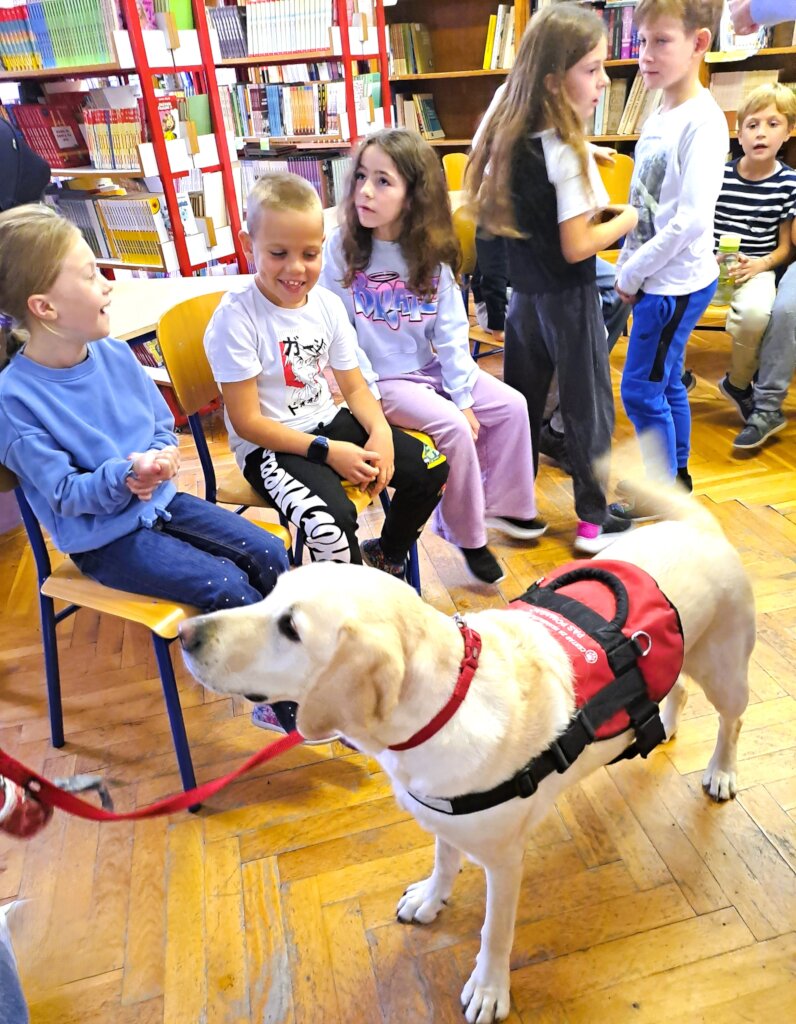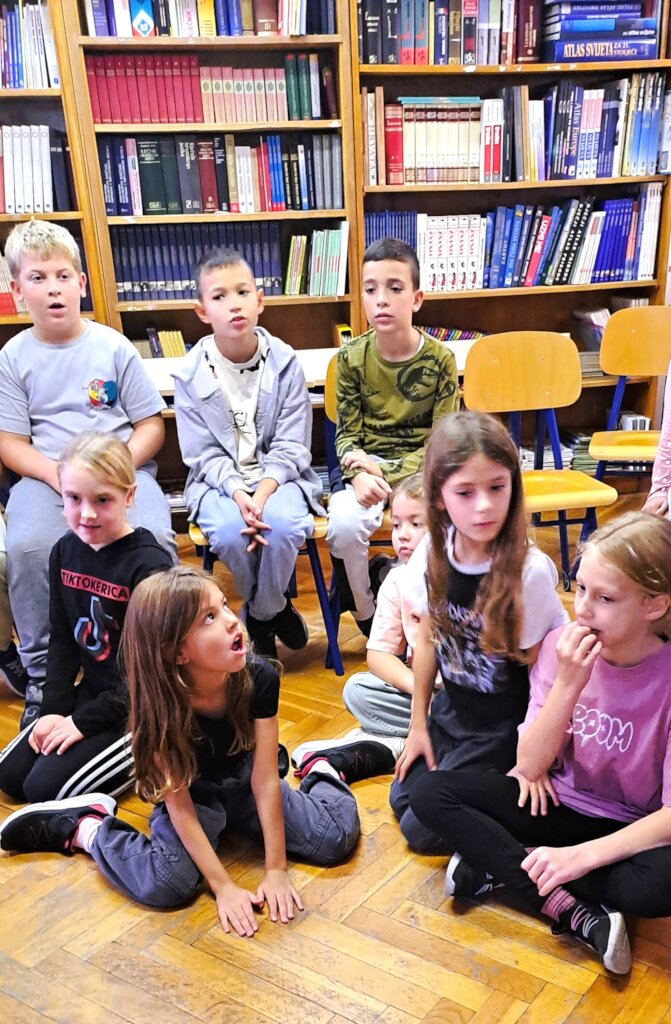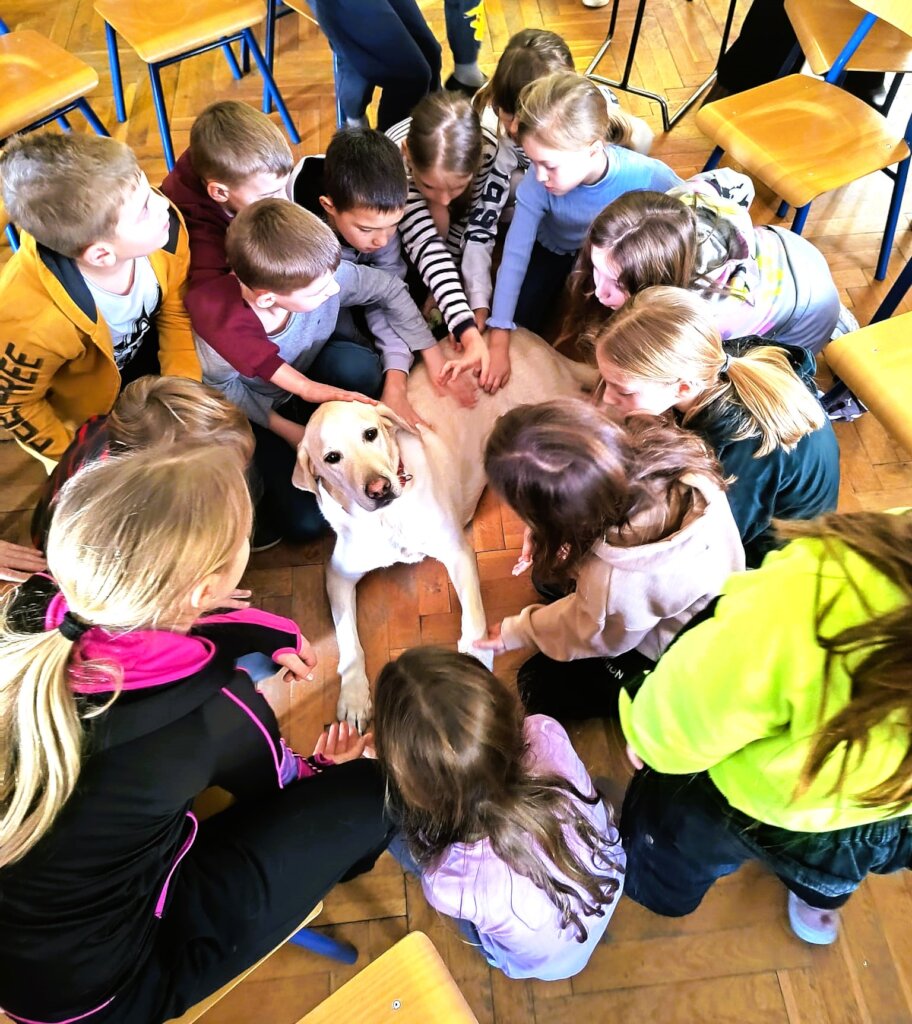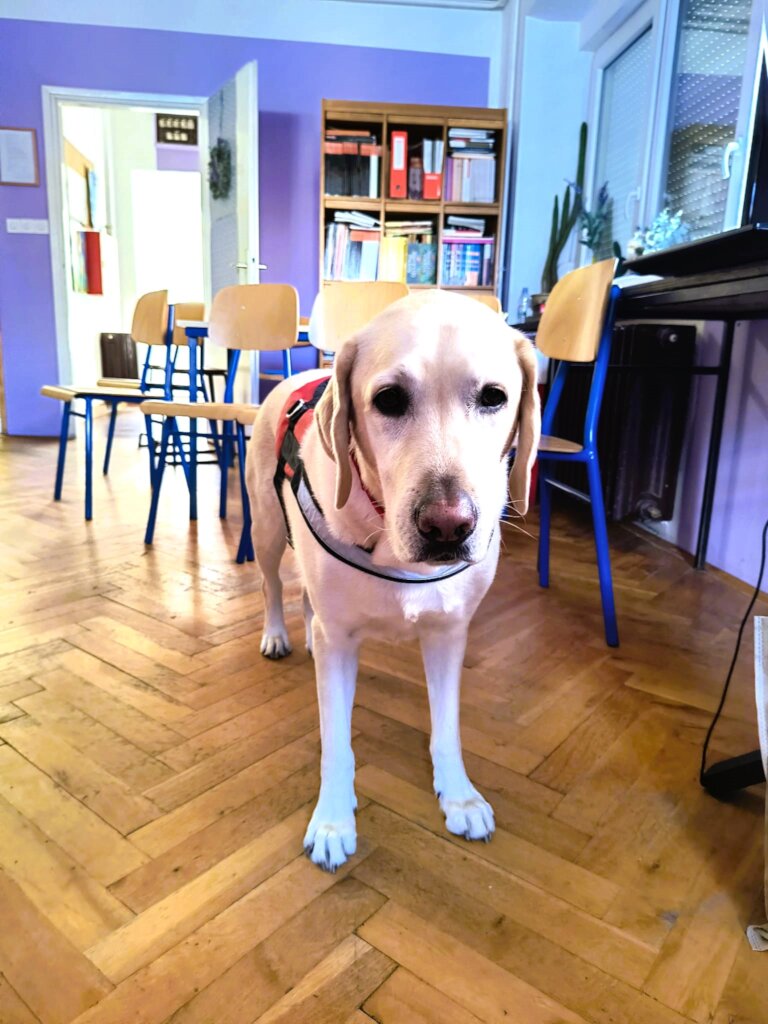By INES RUDELIC | Project Leader and president of the Association
Dear donors,
Thank you for supporting our project!
Our second workshop, "Rico's Paw Support", was a great and exciting experience for the 2nd grade students of the Julija Klovica Elementary School.
We focused on helping children face their fears with the help of the therapy dog Rico.
Psychologist Josipa and library manager Dubravka organized a great get-together. They made sure that Riko was ready to play and that the children had all the
necessary materials so that they could relax and enjoy the lesson spent with the therapy dog.
It was only the second time this group had spent time with Rico, and the interaction the children had with him was truly touching.
Every move or trick Rico performed caused excitement and joy among them.
The therapy dog won the hearts of many children who could not wait to interact with him. Everyone took turns feeding him treats and were overjoyed when
he performed a trick. The genuine affection they showed for Rico created a warm and safe atmosphere, allowing them to talk freely about their fears.
Despite the energy and noise with about 24 children competing for Rico’s attention, he remained calm and patient throughout the workshop, showing off his
wonderful temperament. The scene was colorful, and the rustling of candy only added to the cheerful atmosphere.
This unique workshop was not just an opportunity to face fears; it turned into a touching event that combined fun, learning, and compassion. It will be a fond
memory for all of us, reminding us of the special bonds we can form with our pets and friends.
During the lecture, Josipa explained to the children:
How to recognize and name your own fears?
How to recognize the nature of your fears and visualize them?
How to learn strategies for coping with fear?
• What thoughts go through our heads when we experience certain emotions in our body.
Josipa also paid attention to the fact that these were children aged eight or nine, and she talked about such serious topics in an accessible way for them.
At no point did she allow the children with excessive fear to feel intimidated or isolated.
She brought fear closer to them through play with Rico.
1. How to recognize and name your own fears? (15 min)
Step 1: Do we feel something strange?
Step 2: What exactly are we feeling?
Step 3: What scares us?
Step 4: We name the fear!
When we name our fear, we actually have a little control over it. This helps us:
To understand ourselves: We know what is bothering us.
To talk about it: We can tell someone how we are feeling.
To find solutions: We can figure out how to deal with the fear.
Remember: We all fear something sometimes. It's important to acknowledge our fears, talk about them, and learn how to deal with them.
2. How to recognize the nature of your fears and visualize them? (15 min)
Here are the steps you can follow:
a. Let's talk about emotions!
Try to write down or say what you feel:
Rapid heartbeat: This can mean that you are afraid.
Sweaty palms: This can mean that you are nervous.
Feeling short of breath: This can mean panic.
b. Identifiers and fears!
Try to separate your fears. Ask yourself:
What scares me the most?
Am I afraid of something specific (e.g. heights, the dark, public speaking)?
Is it something that could happen, or is it just a thought or memory?
c. Ask about the fears!
Thinking about when and why it happens.
Am I afraid of the dark because of something that happened in the past?
Have I had bad experiences with something?
d. Visualize Fears!
Now, let's visualize your fear! One way to do this is through visual representation:
Steps:
Close your eyes: Imagine your fear for a moment. What shape would it have? Would it be big or small? Would it be hairy, cold, or hollow?
Give it a name: Give your fear a name. You could call it "The Dark" or "The Spider." When you give it a name, it becomes less scary.
Picture it: Imagine what it looks like. Where are you when you meet it? How do you feel?
Be a friend: Imagine talking to your fear. Ask it why it scares you. You might find that your fear is actually trying to help you in some way.
e. Draw the fear!
After you visualize it, take a piece of paper and a pencil. Try drawing your fear! It doesn't have to be perfect, it's important to show how you see it.
f. Relaxation techniques!
When you sketch or imagine your fears, you can use relaxation techniques:
Deep breathing: Inhale through your nose and exhale through your mouth.
Meditation: Try to focus on your thoughts and feelings without judgment.
g. Talk about your fears:
Share your experiences with someone you trust. This can help.
3. How to learn strategies for coping with fear? (15 min)
Okay, let's dive into strategies for coping with fear. Here's a breakdown of techniques you can learn and practice:
Recognize and Name Your Fear:
Identify the Trigger: What is the specific situation, object, or thought that triggers your fear? Be as precise as possible.
Name the Fear: Give your fear a name (e.g., "fear of public speaking," "anxiety about social situations"). This makes it less abstract and more manageable.
Write it down: Journaling or writing down your fears and anxieties can help you process them and gain perspective.
Challenge Negative Thoughts:
Recognize Physical Symptoms:
Pay attention to how your body reacts to fear (e.g., increased heart rate, shallow breathing, muscle tension).
Learn to Calm Your Body: Use techniques like deep breathing, progressive muscle relaxation, or mindfulness to calm your body's physical response.
Coping Strategies (Actionable Steps):
Breathing Techniques:
Deep Breathing:
Inhale slowly and deeply through your nose, filling your belly with air (diaphragmatic breathing).
Hold your breath for a few seconds.
Exhale slowly through your mouth.
Repeat several times.
Create a Fear Hierarchy:
List your feared situations or objects in order from least to most anxiety-provoking.
Start with the Least Frightening: Gradually expose yourself to the situations on your list, starting with the easiest.
Practice Relaxation: Use relaxation techniques while exposed to the feared situation.
Engage in Activities: Sometimes, fear leads to avoidance. Behavioral activation encourages you to engage in activities that you find meaningful and enjoyable,
even when you don't feel like it. Schedule Activities: Plan and schedule activities to reduce avoidance and increase positive experiences.
Build a Support System:
Talk to Someone:
Share your fears with a trusted friend, family member, or therapist.
Get Enough Sleep:
Sleep deprivation can worsen anxiety.
Eat a Healthy Diet:
Nourish your body and mind with nutritious foods.
Exercise Regularly:
Physical activity can reduce stress and improve mood.
Important Considerations:
Start Small: Don't try to tackle all your fears at once. Begin with the easiest ones and gradually work your way up.
Be Patient: Overcoming fear takes time and effort. Don't get discouraged if you don't see results immediately.
Be Kind to Yourself: It's okay to experience setbacks. Learn from them and keep going.
Seek Professional Help: If your fear is significantly interfering with your life.
The implementation of project activities in the past period is in accordance with the set goals of the project, which refer to:
• socializing and workshops for 24 children with therapy dog Rico and his mentor Josipa,
• conducting various topics that teach us about emotions and ways to control them,
• children's photo session to remember the wonderful gatherings with friends and activities with the therapy dog and
• distribution of gifts that included lots of chocolate and sweets.
All these activities will help in the prevention of later more severe forms of anxiety and at the same time contribute to the solution of related specific
social problems and proactively influence the development of the community as a whole.
Considering the relaxing and stimulating role of therapy dogs for children's development, this type of workshop represents
innovative activity for Croatian school students. So far, thanks to your support, we have included over 160 children aged 8-12,
and our intention is to implement the program in all schools that show interest in this form of holding workshops.
Dear donors, we invite you to stay in touch with us or contact us through social networks or through our website
if you want to know more about our project.
We believe that the pictures in the attachment will also cheer you up.
Warm regards
The Libera Team
Links:
By INES RUDELIC | Project Leader and president of the Association
By INES RUDELIC | Project Leader
Project reports on GlobalGiving are posted directly to globalgiving.org by Project Leaders as they are completed, generally every 3-4 months. To protect the integrity of these documents, GlobalGiving does not alter them; therefore you may find some language or formatting issues.
If you donate to this project or have donated to this project, you can receive an email when this project posts a report. You can also subscribe for reports without donating.
Support this important cause by creating a personalized fundraising page.
Start a Fundraiser


